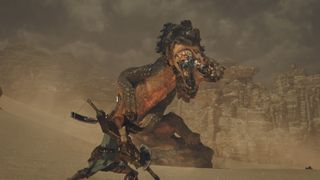Monster Hunter Wilds interview: The future of the franchise, new tricks for all 14 weapons, and the "seamlessness" that really started with Monster Hunter World
Interview | The director and producer of Capcom's Monster Hunter Wilds talk us through the new tricks

Monster Hunter is officially 20 years old, but for many modern fans, Monster Hunter Wilds will only be their second or third game. 2018's Monster Hunter World turned the niche action RPG series into the global hit it was always meant to be with a game loop so watertight, bringing in millions of new players and snowballing into a lengthy reign as the game of the moment. It wasn't a flash in the pan, either. World's explosive popularity carried over to 2021's Monster Hunter Rise. These two games and their Master Rank expansions represent about 48 million of the 100 million units sold in Monster Hunter's history. This is why, to this day, I refer to the phenomenon of a niche series finding mainstream success as pulling a Monster Hunter World.
Monster Hunter is Big big now, so with Monster Hunter Wilds, the series finds itself in a curious position. As great as it was, Monster Hunter Rise was a very different game than World, adopting new mechanics and a more stylized look and feel familiar to older fans but possibly jarring to World newcomers. Rise felt like its own thing, where Wilds looks like World 2 in all but name. It's with Wilds, which ironically faces a bit of a second album situation, that I think we'll see Capcom affirm what Monster Hunter looks like now and into the future. If World set the ball up, Wilds will spike it down. At least, that's the vibe I got while talking (via interpreter) to Monster Hunter Wilds director Yuya Tokuda and series producer Ryozo Tsujimoto at Summer Game Fest, tucked away in an underground room with concrete walls gussied up with Monster Hunter memorabilia
Summer Games Preview
We're diving into the hottest upcoming games out of Summer Game Fest. To find all of our hands-on reports, visit GamesRadar's What's Hot 2024 hub.
Go wild

I haven't spoken to Tsujimoto since Rise was still on the horizon. At the time, we chatted about the guiding themes of Rise, and how each Monster Hunter game tries to do something different. For Rise, it was pick-up-and-play portability shaped by its exclusive launch on the Nintendo Switch. Monster Hunter Wilds, meanwhile, is the first Monster Hunter exclusive to current-gen machines, plus it's launching simultaneously on PC with full crossplay – a reflection of the series' expanded global fan base, and a highly requested feature. So, what is the guiding theme of Wilds?
"Similarly to World, with Wilds we're targeting consoles and PC, and there's a different experience you want when you're going to be sitting down in front of a big screen with your console and high-spec hardware and getting really immersed into the world of the game at home," Tsujimoto begins. "It's a different approach to Rise. Using the latest high-spec console hardware, and on PC as well, lets us bring that immersiveness and seamlessness that we started the series on with World to the next level. That means not just the richness and excitement of the actual gameplay itself, but things like how intelligent the monster AI is can go even further now with this kind of hardware. It brings so many more possibilities."
Longtime Monster Hunter fans may remember discussions about the so-called mainline games and the portable games. World helped unify the series, but I also have a hard time shaking the feeling that Rise goes in the same camp as Generations Ultimate, while World and Wilds have their own camp. Tsujimoto says he doesn't see the series this way. Instead, it's all about "what it is we want to achieve with this title, what we want the player to experience, which hardware we're gonna target and how it's gonna affect the gameplay. The games just come together the way they end up each time."
New tricks

Players will be able to gain access to skills or features that will tie into this new system of using two different weapons at the same time.
Yuya Tokuda
Monster Hunter Wilds has come together with some massive changes. Massive really is the word; the maps in this game are about twice the size of those in the seris' previous games, as a Capcom spokesperson said during a hands-off demo of a hunt. But you don't play Monster Hunter for the maps: you play for the monsters. And we're going to be hunting monsters in all-new ways.
We can now bring two weapons out into the field thanks to the weapon pouch on our Seikret mount, a dinosaur bird we get to ride through those expanded maps. You can swap weapons on the fly, but only your weapons – your armor can only be changed at a camp. Bringing two weapons already raises tons of interesting questions, but this armor limitation made me wonder how this mechanic will be expanded on throughout the game.
Sign up to the 12DOVE Newsletter
Weekly digests, tales from the communities you love, and more
"I can't go into too much detail just yet, because we have a campaign ahead of us to reveal more gameplay details," Tokuda teases, "but I would say that as the story progresses, players will be able to gain access to skills or features that will tie into this new system of using two different weapons at the same time. As to what exactly that means, watch this space. We've just started revealing information."
Of course, some players will proudly bring two of the same weapon, whatever their favorite is – I'm a lance man myself – and Tokuda is fine with that, even if he encourages folks to try two different weapons because it "expands the possibilities so much." But "if you want to bring two different elemental charge blades, or different longswords that have certain properties, that's absolutely what we have in mind. You don't have to bring two different weapons; you can bring two different 'tools'."
Stay focused

One thing to make clear [about Focus] is that it's not a lock-on camera setting.
Yuya Tokuda
There are no new weapons in Monster Hunter Wilds. The series has been sitting pretty at 14 weapons for a while now, but make no mistake: bringing two at once, like a melee and a ranged option, is a big deal. Bigger still is the addition of Focus mode, a new way to engage with monsters with greater precision and make use of a new attack unique to each weapon. These Focus attacks can be used in normal combat, but are especially valuable when attacking the wounds that now appear on specific body parts as you deal damage to monsters with any attacks. If you hit a wound hard enough, you'll deal extra damage to the monster, and Focus attacks will deal even more. It sounds like a brutal mechanic in concept and execution, but this ain't Monster Befriender.
"One thing to make clear is that it's not a lock-on camera setting," Tokuda says of Focus mode. "It's more of a way to make it easier, if I hold down a button when I'm looking to attack or also defend, to set your angle related to the monster more easily than you could before. Especially if we get some new players on board with this game and they're not really accustomed to that kind of action gameplay where you're turning the camera relative to your character and moving your character's position relative to the monster at the same time. It can be quite tricky, to be honest, even if you're a veteran. It just lets you control that angle a lot more easily. You can then bust out an attack in that direction, understanding which part of the monster you want to hit. Or if it's going to be attacking, you know that you'll be able to defend or block at just the right time, and you know that it's going to be connecting properly. That's one major merit of it."
Focus mode seems pretty well-integrated, and I say that partly because while watching the demo I had a hard time distinguishing when the hunter was using Focus attacks. There's nothing limiting how much you can use Focus mode, like a resource such as stamina, so you dip in and out of it as much as you want or need to. It's Monster Hunter's latest cherry on top, another little variable for a tried-and-true formula. "It's extra things you can think about and ways to deal damage during the hunt," as Tokuda puts it.
Parry this, you filthy casual

I look forward to telling myself I'll try something new for this game and then inevitably using the lance for another 500 hours.
It's exciting to hear that every weapon is getting new attacks, but as we come to the end of the interview, I end up thinking about some existing attacks. In recent Monster Hunter Games, it's felt like more and more weapons are getting moves that let them block, parry, or otherwise counter incoming damage – perhaps a natural step in the arms race between smarter monsters and stronger hunters. This led to huge swings in playstyle for the greatsword and switch ax in the case of Rise, to say nothing of the longsword in World. I was curious to see if Wilds will continue this trend.
Sure enough, the first gameplay trailer features what sure looks like another greatsword parry. I'm not necessarily complaining – I've said before that if you put a parry in your video game, I will play your video game. However, it definitely stands out from older games, which focused more on proactive positioning. Is this the future of Monster Hunter combat? I put the question to Tokuda.
"It's not so much that I've had an intentional design decision to gradually make all weapons become a sort of counter-parry system functionality," he clarifies. "Certainly, not all weapons have such a move in their tool set. I would say that every time we release a new title – and the same goes for Monster Hunter Wilds – we look at all 14 weapon types and try to keep pushing them down their own paths of how unique they are and how fun to use they are. They all feel so fundamentally different from each other that there isn't really one thing I want to do to all weapons. That would almost bring them too close to each other."

Every time we release a new title...we look at all 14 weapon types and try to keep pushing them down their own paths of how unique they are
Yuya Tokuda
This process of making each weapon distinct, yet multi-functional, is one that Capcom has clearly thought a lot about in relation to the changing landscape of Monster Hunter as it evolves over time. "As we improve each weapon and consider how it's going to be approached for each title, like if it's got a gap in its move set that is filled by something that could be usable as a parry - but also these moves are generally usable at any time, it isn't something you can only pull off if you do it at this timing - it's more [about] maybe this weapon lacked something to counter the verticality that's now in the game with these three-dimensional maps. I would've added a move that could be used that way."
Tokuda's undoubtedly right about one thing: weapons get better and more fun to use with every new Monster Hunter game. I'm dying to see how they've been upgraded this time. I look forward to telling myself I'll try something new for this game and then inevitably using the lance for another 500 hours. In any case, the Monster Hunter tank in my brain is getting perilously close to empty. I can only go so long without playing this series; it's somewhere between food and shelter on my hierarchy of needs. It feeds a very specific hunger, and it feels like home.
To that end, Wilds looks like home. Much remains unknown, but this series has a hit rate that would embarrass Olympic shooters, and I'm more confident than ever that Wilds will be a meaningful step up from World. Onward to the inevitable – but still painfully far-off – open beta before the 2025 release.
Check out all the upcoming PS5 games to keep an eye on, from Monster Hunter Wilds to GTA 6.

Austin has been a game journalist for 12 years, having freelanced for the likes of PC Gamer, Eurogamer, IGN, Sports Illustrated, and more while finishing his journalism degree. He's been with 12DOVE since 2019. They've yet to realize his position is a cover for his career-spanning Destiny column, and he's kept the ruse going with a lot of news and the occasional feature, all while playing as many roguelikes as possible.
Most Popular


